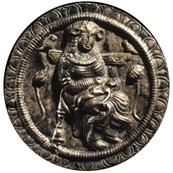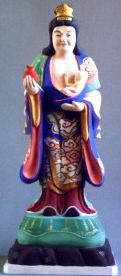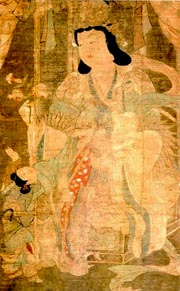|

Kishimojin
in Chinese
|
|
Ki of Kishimojin is composed of a large demon’s head on top; under the head are legs, or vapor. Demons from the mountains or uninhabited areas would come into the villages and steal the head of a person and run around wearing it. These demons are also known as hungry ghosts because they still have unresolved “hungers” or issues. When they satisfy their “hunger” they can move on to the next phases of life/death. |
|
|
Shi of Kishimojin is a child wrapped in swaddling. The horizontal line are his/her arms. |
|
|
Mo is mother. The form of Mo is that of Nu the radical (root word) for woman. The two squares inside this structure represent a mother’s breasts. The dots inside the squares are her nipples. |
|
|
Jin of Kishimojin is composed of two elemental characters. On the right is two hands holding a rope. The rope extends the usefulness of the hands. It means “to extend” [oneself for others]. On the left is a compound that is the light of the sun, moon, and stars coming from heaven. It means the instructions (like omens, etc.) from the heavens. This jin is the same “jin” that is found in Shoten zenjin. Just as the Shoten Zenjin are heavenly protectors, so is Kishimojin. |
Ki = DemonKishimojin is commonly translated as “Mother of Demon Children”, but more accurately she is the Demon that protects mothers and children. In some “Nichiren” sects, she is the central object of worship and there are special ceremonies that pay homage to her.
Shi = Child
Mo = Mother
Jin = Heavenly (Cosmic) Protector
According to legend, Kishimojin drank the blood of children so that she could provide mother’s milk to her favorite child. Mothers in the nearby villages asked the Buddha if he could put an end to this practice. So the Buddha caused Kishimojin’s child to be invisible to her. She searched franticly for him (even though he was near her at all times) and eventually she came to the Buddha for help. The Buddha asked her how she felt about not being able to find her child. When Kishimojin told him of her great anguish, the Buddha explained that that is how she made other mothers feel when she took their children. After that, Kishimojin vowed to protect mothers and children. Later, in the Dharani (Spells) 26th Chapter of the Lotus Sutra, she and her ten daughters vow to protect the practitioners of the Lotus Sutra in the evil age that was to come.


